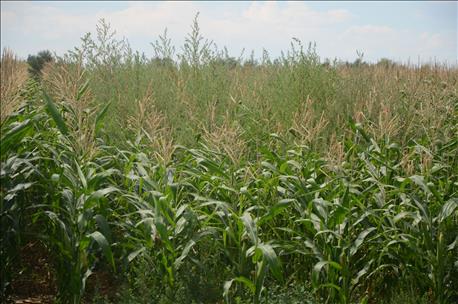
Last month I wrote about the challenges growers are facing throughout the Midwest and South with herbicide-resistant Palmer amaranth. It's devastating to think that one weed species by itself — albeit one with resistance to as many as six different modes of action — could put farmers out of business.
There's no doubt it can happen in Nebraska, or at least make growers radically change their farming practices. That was most apparent in a recent trip to the Nebraska Panhandle I made in early August, where, in addition to ALS-resistant Palmer amaranth, growers are dealing with their own set of weed challenges.

DIVERSE ROTATION: One way growers in the western reaches of the state are dealing with kochia — especially resistant kochia as pictured above — is mixing up their crop rotation, which forces them to use multiple modes of action and plant crops that compete better with weeds.
One of the most obvious is glyphosate-resistant kochia, which is infesting over 2 million acres in western Nebraska. As one Extension weed management specialist put it to me, when managing kochia — or any resistant weed for that matter – growers have to consider all the tools they have available.
But it isn't just kochia. As I mentioned earlier, resistant Palmer amaranth has, in some cases, infested entire 160-center pivot circles. And growers in the Panhandle and other areas of the western High Plains know just how much of a bear it can be to control cheatgrass.
The challenge for growers in this semi-arid climate is that water comes at a premium. In places with 14 to 18 inches of annual rainfall, many growers and researchers alike point out the best way to conserve water is to store more in the soil with improved soil structure, aggregate stability, infiltration and residue to keep the ground covered. So, when chemistries outlive their usefulness, it doesn't leave many options.
But farmers and ranchers on the High Plains are resilient, and have demonstrated their ability to adapt to challenges — in this case, a challenge that is adapting with them.
Several Panhandle growers I've visited this year have been adapting — not as a primary benefit, but a secondary benefit to soil health benefits — by mixing up their rotation. They do this by either bringing a pulse crop like yellow field peas into the mix or planting a cover crop when soil moisture supplies allow for it. Whatever the case may be, expanding the rotation beyond irrigated corn and sugarbeets or beyond dryland wheat-summer fallow has shown to be a viable option in the war on weeds.
The reason isn't necessarily the rotation itself, but the fact that it forces growers to expand their herbicide use and bring in different modes of action — ideally multiples modes of action every year. Certain crops might provide greater competition against certain weeds at certain times of the year than others, or provide a bigger window to control weeds with a burndown application or even tillage.
In Nebraska Farmer and in this week's web articles, you can read about a research trial demonstrating just that at the University of Nebraska Panhandle Research and Extension Center in Scottsbluff. The goal of the research trial, a joint effort between Montana State University and the University of Wyoming, is to highlight different methods of control for resistant kochia, and how those practices work when combined together, says Nevin Lawrence, UNL associate professor and Extension weed management specialist. As Lawrence notes, "Where we had the most diverse rotation, it's been pretty much kochia-free."
See related story: Panhandle research explores different ways to manage resistant kochia
About the Author(s)
You May Also Like






